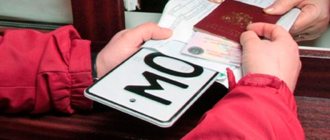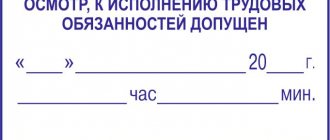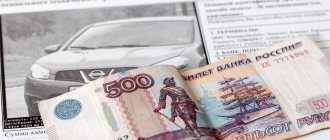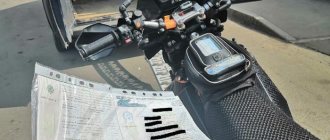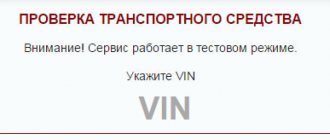Looking at the consonance of the concepts of inspection and inspection, one gets the impression that they are one and the same. In fact, it was not for nothing that the legislator introduced a division in concepts. For each type of action there is a special procedure for its implementation, which is regulated by administrative legislation.
Dear readers! Our articles talk about typical ways to resolve legal issues, but each case is unique. If you want to find out how to solve your particular problem, please use the online consultant form on the right or call. It's fast and free!
It is very important for every driver to know the differences between them and to be able to reasonably refuse a traffic police inspector to carry out this or that action and the procedure for documenting it.
In case of an urgent desire of a law enforcement officer to carry out actions, he must be able to competently demand compliance with his rights and obligations, as well as know and demand the proper procedural execution of documents.
Grounds for conducting a personal search
Before operating with this concept, it is necessary to find out what the legislation means by it. Its foundations are revealed in Art. 27.7 of the Code of Administrative Offenses of the Russian Federation, in accordance with it, this is an inspection of things on a person and with him. This is hand luggage (bags, briefcases, packages), luggage, hunting and fishing items, etc.
The citizen's consent is not required to carry out the procedure.
Personal search is an administrative procedural measure. The basis for its conduct is the commission of administrative offenses, information about the citizen’s possession of weapons, explosives, psychotropic and narcotic drugs.
Information must be obtained from reliable sources. They can be statements from individuals and legal entities, government bodies, police orientations.
Hand luggage inspection procedure.
A protocol must be kept in the presence of two witnesses or using video recording. If there is information that the person subjected to a personal search may have a weapon or show resistance, witnesses are not needed. They may also not be present if video surveillance or video recording is being carried out.
During this procedure, an examination of the body, clothing, and items in the citizen’s possession are examined. The integrity of things is not compromised. The citizen is examined, not searched. Everything discovered during the inspection is entered into the protocol. This should not just be a list, but a description of each item, indicating identification characteristics. If the violator is a minor or incompetent, then all actions are performed in the presence of legal representatives.
What is the difference between an inspection and an inspection?
The concepts and basic rules for conducting inspection and examination of vehicles are defined in Order of the Ministry of Internal Affairs of Russia dated March 2, 2009 N 185 (as amended on December 22, 2014) “On approval of the Administrative Regulations of the Ministry of Internal Affairs of the Russian Federation for the execution of the state function of monitoring and supervising compliance by road users requirements in the field of road safety” and are presented in a comparative table.
comparison table
| Comparison options | Inspection | Search |
| Definition of the concept | Visual inspection of the machine | Inspection without compromising the structural integrity of the machine (checking the contents) |
| Reasons for carrying out |
|
|
| Features of the procedure |
|
|
| Document drawn up during the procedure | Inspection report of the vehicle and the cargo transported on it | Vehicle inspection protocol |
| Articles of the Order of the Ministry of Internal Affairs of the Russian Federation dated 03/02/2009 No. 185 regulating the procedure | Art.149-154 | Art.155-164 |
| According to the results | If there are no grounds for other procedural actions, it is allowed to continue the movement. | When found:
|
| Comments |
| detailed procedure
|
Unauthorized actions of a traffic police inspector that violate the rules established by law for conducting inspections and searches can be punished as arbitrariness of an official (Article 19.1 of the Code of Administrative Offenses of the Russian Federation):
- warning;
- or a fine of 300-500 rubles.
If the driver’s rights are violated, it is worthwhile, recording what is happening on video or a voice recorder, to wait for the situation to develop. Having refused the inspection, invite the traffic police inspector to conduct an inspection, having previously familiarized the driver with the grounds for this procedure and provided two witnesses. The calm behavior of the driver will show the traffic police officers that most likely there is nothing prohibited in the car.
Just in case, after inspection and inspection, it is better to check your car yourself again (trunk, under the seats, etc.) in order to exclude the illegal practice of unscrupulous police officers, when “some” “inspect”, and “others”, a couple of kilometers later , "find".
Knowledge of the norms of current laws allows the driver to competently protect himself from unpleasant surprises and arbitrariness.
Who has the right to conduct searches of citizens?
In Art. 27.2, 27.3 of the Code of Administrative Offenses provides a list of government bodies whose responsibilities include monitoring the implementation of legislation in various areas.
The following officials have the right to conduct inspections and draw up protocols:
- Police - upon detection of offenses provided for in paragraph 1, part 2, art. 28.3 of the Code of Administrative Offenses independently or when officials contact them, Art. 27.2, 27.3 Code of Administrative Offences.
- The National Guard, as well as departmental and non-departmental security subordinate to it.
- Bodies exercising control or supervision over the implementation of rules for the use of transport.
- Military traffic police - in case of violation of traffic rules by military drivers in transport of the Russian Armed Forces, the National Guard, civil defense troops, engineering, technical and road construction units.
- Bodies monitoring compliance with legislation on environmental protection, forestry, livestock farming, fisheries, and water resources.
- Border troops, bodies of the Ministry of Internal Affairs, military personnel and other persons entrusted with the responsibilities of protecting the state border.
- Border Troops - when identifying administrative offenses in internal sea waters.
- Customs authorities - in case of violation of Customs rules.
- Drug control authorities.
- Carrying out counter-terrorism operations and revealing violations of the law under Art. 20.27 Code of Administrative Offences.
- Bailiffs who ensure the established order in the courts.
- Migration authorities.
Differences
Drivers often ask the question of how an inspection differs from a search, and who is authorized to carry out these actions.
Both procedures are subject to recording in the form of a protocol; the participation of witnesses during the activities is mandatory. In relation to a person and property, both an inspection and a search can be carried out, but a home is subject only to a search.
An important nuance - a representative of the patrol service only conducts a search; the search is carried out by operational officers.
Another difference between an inspection and a search is that the inspection does not involve violating the integrity of objects; a search may have such consequences. When carrying out operational investigative activities, things and objects may be damaged, but as a result of an inspection, such damage is excluded.
Procedure for carrying out the procedure by police officers
A personal search is carried out by officials authorized to perform this action and who have the right to draw up a protocol.
Mandatory conditions for production are the following:
- The searched citizen must be explained the reason (basis) for this procedure.
- Invite him to provide for examination documents, things and objects with which administrative offenses were committed.
- The search of a citizen is carried out by a police officer of the same gender as him.
- Two witnesses are invited. Their role can be played by people who must meet the following requirements: be over 18 years of age, have no interest in the case, sober, sane, not part of the squad, not familiar with the police, of the same sex as the suspect.
- The inspection procedure must be carried out in premises that meet sanitary requirements and exclude access by unauthorized persons.
- The person being searched is ensured: safety, health, dignity, confidentiality of personal life is guaranteed, except for cases provided for by law.
- When performing an inspection, if there is information about the presence of explosives or weapons, the procedure is carried out in the absence of witnesses. When filming video, the presence of the latter may also not be necessary.
- A protocol is drawn up in which all information received is entered.
- Discovered items to which all established methods of recording material evidence have been applied (description, measurement, photography, video recording) are confiscated. They are packaged, sealed and attached to the case as evidence.
- What is written is read aloud. The suspect and witnesses are asked if they have any questions. If not, then a record of this is entered into the protocol, which is signed by the citizen being examined and by witnesses. One copy is given to the suspect.
Personal search by police.
There are times when police want to conduct a personal search right on the street. Here it is necessary to require the invitation of two witnesses.
What to do if an inspector violates a driver’s rights?
In the event that employees of the Ministry of Internal Affairs violate the driver’s rights, which is expressed in infringement, refusal to provide official documents to record the police officer’s data, or other actions that directly violate the rights, certain actions must be taken.
These include:
- carefully read every word of the inspector, which is recorded in the protocol;
- never refuse to provide explanations in the protocol;
- always indicate what you disagree with;
- in the case where there is free space left in the place where the explanation is written, be sure to write the English “Z” with a strikethrough in the middle. This is necessary so that further entries do not appear in the protocol later;
- If the police officer has not explained your rights, do not sign the places in which it is indicated that they have been explained. In the place where the explanation is written - indicate the fact of the traffic police officer’s refusal to familiarize and explain the rights;
- do not sign the box “received a copy of the protocol” if a copy of the protocol is not in your hands;
- in case of refusal to provide a copy before signing this column, indicate in the explanation that the employee refused to provide a copy of the protocol;
- If possible, take photos and videos of what is happening; the activities of government bodies are transparent! No one has the right to prohibit video recording of your communication with a traffic police officer;
- ask questions to the employee directly and clearly, and also demand clarification and clarification of the employee’s actions;
- Do not be rude to a police officer under any circumstances;
- in the event that it is no longer possible to continue verbal communication, call the hotline or hotline (for participants in the international movement, dial the toll-free number 112), where you state the circumstances of the situation;
- in the event that an employee’s actions raise suspicions and fears for one’s own life, call the police immediately! At the same time, when communicating with the dispatcher, there is no need to report that this is a police officer; provide information as if you were a witness to a crime. Demand that an investigative team come to you. In the conversation, demand that measures be taken as soon as possible to ensure safety and eliminate the threat to life and health.
Verification of documents
This procedure is carried out if there are reasons to believe that a citizen has committed an offense or to suspect that he is wanted.
Reasons for this:
- The person is caught in the act of committing an offense.
- Eyewitnesses point to this citizen.
- Traces of a crime were found on clothing or body.
- There are similarities with a wanted criminal.
- Evidence from outdoor surveillance cameras.
- Inappropriate behavior. The man looks around, runs away from the police, etc.
Checking a citizen's documents.
What documents do you need to have with you as identification (one is enough):
- civil, foreign or diplomatic passport;
- military ID;
- birth certificate;
- seaman's passport;
- service ID.
Who cannot be inspected
According to federal laws, a list of persons who are not subject to personal search is established:
- presidents of the country: current and former;
- members of the Federation Council and State Duma deputies;
- judges and arbitration assessors;
- prosecutors and employees of the Investigative Committee;
- FSB officers during the execution of a task;
- State security officers during the performance of their duties;
- Commissioner for Human Rights;
- citizens of other countries with diplomatic immunity.
But there are exceptions - this is a mandatory pre-flight inspection in which everyone participates. According to paragraph 3 of Art. 85 of the Air Code, citizens who have not passed it are not allowed on board the ship.
Features of administrative detention
This is a short-term interim measure, which takes place in exceptional cases in accordance with Art. 27.3 Code of Administrative Offences. She is preceded by delivery in order to be able to examine the suspect. It is used when a correct and quick investigation is necessary. The goal is to stop the offense when all measures of influence have been exhausted: persuasion, orders. If a citizen is law-abiding, then this measure does not apply to him.
Administrative detention procedure.
In accordance with Art. 27.4. The Code of Administrative Offenses of the Russian Federation draws up a protocol on administrative detention, which is issued at the request of the offender. The detention period is 3 hours. It is calculated from the moment the offense was committed, and not from the time of delivery to the police.
Vehicle inspection
If there are suspicions that there are instruments or objects of an offense or crime in the vehicle, then a search of the vehicle is allowed.
The procedure is carried out without modifying the design features of the car, that is, disassembling the car’s components is not allowed.
At the moment, witnesses are not required to carry out the procedure, only taking photos or videos is sufficient.
In this case, a protocol is drawn up that describes the procedure, the use of special technical means, and is also signed by the driver and the person who compiled it.
A citizen cannot refuse, since this may be followed by other security measures in the case.
For example, detaining a citizen along with a car, after which the car is placed in a fine parking lot.
Actions if the duty officer refuses to accept an application
Based on Order of the Ministry of Internal Affairs of Russia No. 140 dated March 1, 2012, territorial police stations must accept, register and consider all applications, regardless of citizenship.
What to do if you are refused:
- Warn the police officer on duty that his actions are unlawful and you will be forced to appeal his refusal. Speak politely, without emotion.
- Rewrite the badge details.
- Ask to invite the chief of police or any official in his place.
- If the duty officer did not do this, then call the hotline at 112 in his presence. Explain that they are refusing to accept your application.
You can call the prosecutor's office. It is advisable to make a video recording. If this does not help, then write a complaint to a higher authority of the Ministry of Internal Affairs.
Inspection
There is no concept of “inspection” in any regulatory legislative document. This is exactly what law enforcement officials usually use, because... not many drivers can give a legitimate fight.
Inspection applies:
- to check the correspondence of the car data in the title and real car data (for example, VIN number, access to which the driver must provide if necessary and justification for the requirement);
- if the inspector has information that a similar vehicle is wanted or the cargo being transported is illegal;
- if the cargo does not correspond to the documents presented, in particular, the size of the cargo, the rules of its transportation, etc.
Since 2012, inspections have been carried out with the preparation of a simplified protocol. But a very small number of traffic police inspectors comply with this rule, and even fewer people know about this requirement.
Actions when extorting a bribe
This illegal behavior by police officers is common. If you have not committed any offenses, then try to prevent extortion. To do this, take out your phone, turn on the video recording or voice recorder. This sometimes helps. Or make a discreet recording on video or a voice recorder, it will be useful to you.
Actions when extorting a bribe.
Further actions will be as follows:
- Use the hotline by calling 8-800-250-02-35 and reporting that a bribe is being extorted from you.
- Write a statement to the Internal Security Service, send it by registered mail with notification. Or better yet, take it yourself. Remember that giving a bribe is the same crime as receiving it. Therefore, to avoid liability, you should contact law enforcement agencies.
- You can file a complaint with the prosecutor's office.
Difference between inspection and inspection
An inspection is an administrative and preventive measure. It differs from inspection by the main goals:
- It is carried out to prevent citizens from committing actions that could lead to an accident or emergency.
- Is a warning against committing a violation of the law. This measure is preventive in nature.
Therefore, the main difference between the procedures is the administrative offense committed or its prevention.
The basis for conducting a personal inspection may be a violation of the rules for citizens to be in crowded places. These could be airports, train stations, stadiums, premises for entertainment events, etc. Drawing up a protocol on personal inspection is not provided for by law, but during an inspection it is mandatory.
Grounds and procedure for inspection
New administrative regulations of the traffic police 2017-2018 and its features
Traffic police officers serving at stationary checkpoints or patrolling the roads are empowered to stop cars and check drivers’ documents confirming the right to legally use the car. During the control, the police inspector can make a visual assessment of the vehicle (the outside of the body, license plates, the situation inside the car).
Such an inspection is carried out in order to determine the compliance of the vehicle with the documents provided by the driver, as well as to ensure that passengers are safe. For this type of audit, the police officer does not need additional powers.
But there is another form of inspection that is carried out to prevent the car from being used for illegal purposes. The basis is the availability of operational information about a possible violation. Most often, this situation occurs during thefts.
During the inspection, an act is drawn up (without involving witnesses) and one copy of the document is given to the driver of the car.
